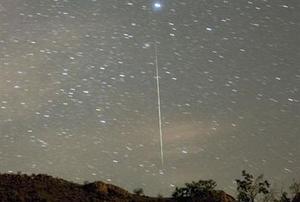
|
| ©Unknown |
| A Geminid meteor streaks across the sky against a field of star trails in this 1 1/2-minute exposure early Dec. 14, 2006, near Willow Beach, Arizona. |
"Had there been a full moon that night, I'm sure it would have covered three quarters of it. I bet you it lasted six to eight seconds before it disappeared behind the hill on the edge of town. There were all kinds of colours bursting out of it. The tail lasted a good two hours."
Balsom, a hotel worker, was launching a weather balloon as part of his daily work routine when the fireball burst across the sky over Resolute, the small Inuit village he lives in.
He wasn't the only person left star-struck by the sight. It also caught the attention of pilots, meteorologists, miners and the Department of National Defence.
At first, Balsom thought he was seeing a American spy satellite being shot down by the U.S. Navy. But when he called his hotel's head office later that morning, he learned it wasn't the satellite.
That's when he concluded it was a space rock or meteorite crashing through the Earth's atmosphere - not a UFO, as a few people have suggested.
"When it finally went down, you could see this big white cloud in the sky that just sat there for the longest time," he said.
"It was the event of the century."
Most meteorites are remnants from asteroids, some from comets. Among the most coveted are those that come from Mars.
Longtime Resolute resident Wayne Davidson was just as ecstatic in describing what he saw.
"The Inuit up here have been on the radio talking about it for days," he said.
An avid skywatcher with a background in meteorology, Davidson suggested the fireball may have been as big or bigger than the one that crashed onto frozen Tagish Lake in the Yukon several years ago.
That yielded a cluster of rare carbonaceous chondritese - rare meteorites that contain both water and organic compounds. Scientists covet these as clues from the early solar system.
University of Calgary planetary scientist Alan Hildebrand has no doubt the sighting was spectacular, a once-in-a lifetime opportunity for anyone who saw it falling. But he doubts that it was big enough to be crater-forming.
"Meteorites may have fallen to Earth, but the atmosphere is really too hostile for small falling objects to penetrate to form a crater on the ground." Without more detailed eyewitness reports, launching a search in such a large, remote area would be too expensive and unlikely to produce anything, he said.
By way of comparison, Hildebrand notes, the Tagish Lake fireball came toward Earth as a 100-tonne space rock. It was so big that its fiery atmospheric entry allowed scientists to calculate its orbit before it hit the Earth.
The Tagish Lake space rock exploded with nearly one-tenth the atmospheric blast power of the Hiroshima nuclear bomb. Had it not been for a local resident who found some fragments while driving with some construction materials for his lodge on the frozen lake, scientists might never have recovered anything.
"I don't want to diminish anyone's enthusiasm for getting excited about these kinds of sightings," says Hildebrand, "But if they do see something, they should take note where they were, what time it was, and what they saw. Then they should report to local law enforcement, search and rescue, or NavCanada right away."
estruzik@thejournal.canwest.com



Reader Comments
to our Newsletter